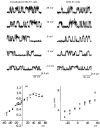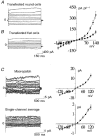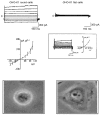The nuclear chloride ion channel NCC27 is involved in regulation of the cell cycle
- PMID: 11195932
- PMCID: PMC2270212
- DOI: 10.1111/j.1469-7793.2000.00541.x
The nuclear chloride ion channel NCC27 is involved in regulation of the cell cycle
Abstract
NCC27 is a nuclear chloride ion channel, identified in the PMA-activated U937 human monocyte cell line. NCC27 mRNA is expressed in virtually all cells and tissues and the gene encoding NCC27 is also highly conserved. Because of these factors, we have examined the hypothesis that NCC27 is involved in cell cycle regulation. Electrophysiological studies in Chinese hamster ovary (CHO-K1) cells indicated that NCC27 chloride conductance varied according to the stage of the cell cycle, being expressed only on the plasma membrane of cells in G2/M phase. We also demonstrate that Cl- ion channel blockers known to block NCC27 led to arrest of CHO-K1 cells in the G2/M stage of the cell cycle, the same stage at which this ion channel is selectively expressed on the plasma membrane. These data strongly support the hypothesis that NCC27 is involved, in some as yet undetermined manner, in regulation of the cell cycle.
Figures









References
-
- Alberts B, Bray D, Lewis J, Raff M, Roberts K, Watson JD. Molecular Biology of the Cell. New York and London: Garland Publishing, Inc; 1994. pp. 863–910.
-
- Assandri R, Mazzanti M. Ionic permeability on isolated mouse liver nuclei: influence of ATP and Ca2+ Journal of Membrane Biology. 1997;157:301–309. - PubMed
-
- Bubien JK, Kirk KL, Rado TA, Frizzell RA. Cell cycle dependence of chloride permeability in normal and cystic fibrosis lymphocytes. Science. 1990;248:1416–1419. - PubMed
Publication types
MeSH terms
Substances
LinkOut - more resources
Full Text Sources
Other Literature Sources
Molecular Biology Databases
Research Materials
Miscellaneous

